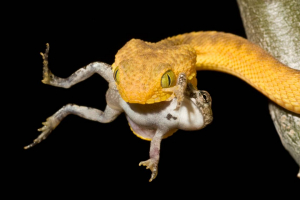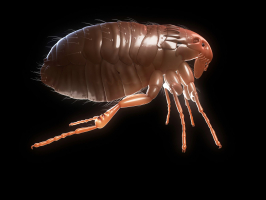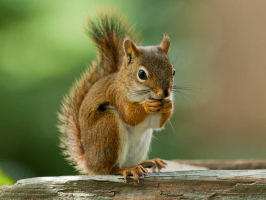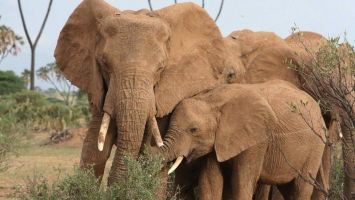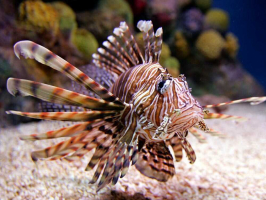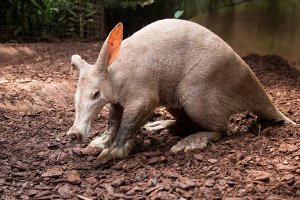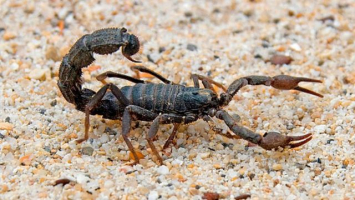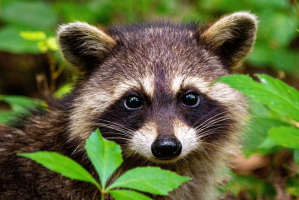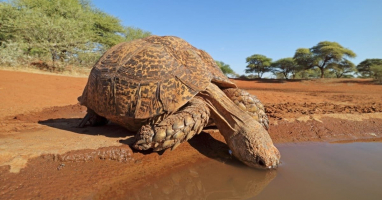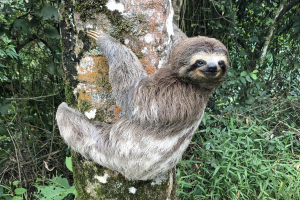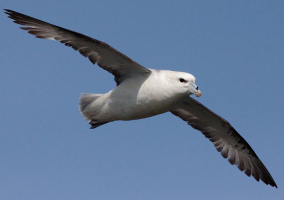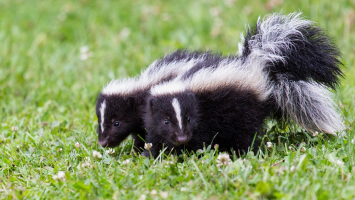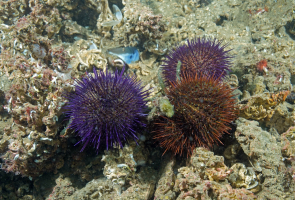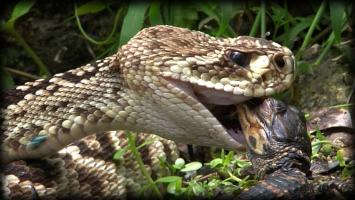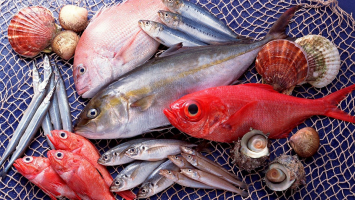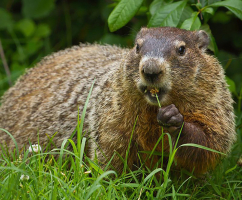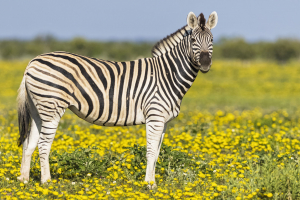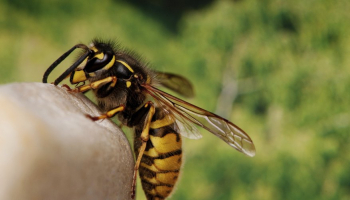Top 10 Predators of Ants that Eat Ants
It is pretty intriguing that ants may be found almost anywhere, at home, on the road, in a restaurant, or in your yard. Except for Antarctica, almost every ... read more...nation on earth is home to ants. There are more than 10,000 different kinds of ants, and each one has a unique size and form. There are 1,250,000 ants for every human, thus there are a lot of them. These ants can defend themselves by using dangerously enormous pincers, and some can fly away from attackers. It should come as no surprise that ants are surrounded by predators given that they are practically ubiquitous. There are creatures and insects that have evolved to consume and hunt ants because they are so plentiful, despite their tiny size and difficulty being seen by larger predators. Ants and anteaters are examples of animals and insects that employ unique methods to catch and hunt their little prey. Therefore, Toplist would like to introduce readers to the 10 Predators of Ants that Eat Ants that can make you interesting.
-
One of the 10 Predators of Ants that Eat Ants that might surprise you the most is ants. Despite their little size, ants may be very harmful. Ants require protein to live and grow, just like all other species do. They will not pass up a simple chance because they can obtain these proteins from other ants.
Since there are 12,000 different kinds of ants around the globe, ants frequently compete with one another and with other colonies for food. Ants are capable of cannibalism. The native ants will drive out the newly arrived ones if one colony of ants is near another colony of a different species. A troop of ants will steal the eggs and kill the other neighboring colonies if they become aware that there are other colonies close by so that their own colony may grow even larger. Army ants are infamous for breaking into other ants' nests in search of eggs and larvae to consume. In other situations, the queen can devour her young if she is in danger due to a shortage of food supplies.
Ants possess what is known as mandibles or jaws. They are employed in food processing, hunting, chopping, holding, and excavating. They aid ants in gathering any food scraps still on the ground and savoring them for simple consumption. Ants also have antennae, which are among their most crucial body components. Ants can smell, touch, and feel anything thanks to their antennae, which help them to locate food sources and communicate with one another.
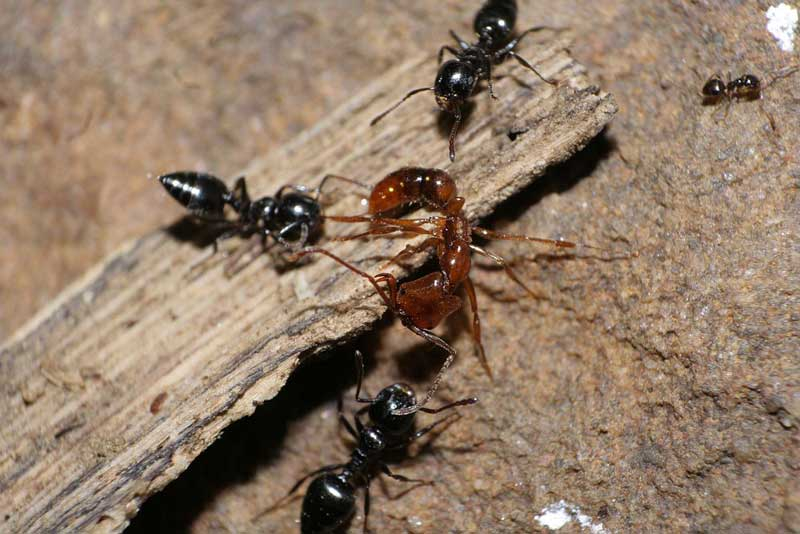
tpwd.texas.gov 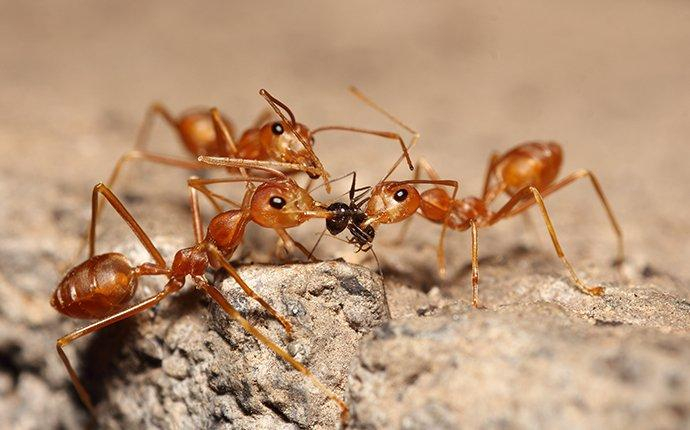
rivercitypc.net -
One of the most prevalent arachnids on the globe is the spider. In fact, experts believe that you are never more than 10 feet from a spider at any one time. With the exception of Antarctica, they inhabit every continent and are highly varied. There are more than 3,400 different species of spiders only in North America. Some spiders are extremely little, having leg spans of about a quarter inch, while others are much bigger, with leg spans of up to a foot. They are arthropods, and the exterior of their body is covered in a tough, protective exoskeleton. We are aware that they mostly eat insects.
Spiders like eating ants, something many people might not be aware of. These ant predators are renowned for consuming a wide range of ant species from throughout the globe. There are certain spider species that have developed specifically to devour ants. Ants can become entangled in spider webs because the majority of them will crawl up trees, walls, and other high areas. Some spiders do not need to build webs in high areas since they can hunt from the ground. Spiders that aggressively pursue ants include jumping spiders, black widows, and other species. Another kind of spider, the Zodarion rubidium, only feeds on ants. They mimic ants, and even their physical structure is similar to ants.
Nutrition is important for the survival of the Zodarion rubidium spider, which solely eats ants, and different portions of ants have varying nutritional values. Because of this, these spiders prioritize the sections of the ant that are most nutritious when deciding which ones to consume first. The front ends, which are rich in protein, are consumed before the back half, also known as the gaster.
Maxime Ayotte Torn80cj -
Vespula vulgaris, another name for the wasp, is endemic to the Northern Hemisphere but has spread to temperate regions of the Southern Hemisphere, including New Zealand. In this category, there are many various sizes. Because they are so tiny, certain parasitic wasps can grow into adults within the eggs of other insects. Others are above 3 cm long, powerful predators. All have teeth for chewing, and adults have a tenuous relationship between their final two bodily parts (the abdomen and the thorax). As adults, all have four distinct wings, with the front pair being bigger than the rear pair (queen and male ants also have wings, but they only develop them briefly). Ants frequently have a permanent bend in their antennae whereas bees and wasps have straight antennae.
These insects have a reputation for consuming many different types of insects and may bite people quite painfully. The larvae of this ant predator initially adhere to ants and feed on them. These larvae will use their aroma to pass for ants, much as the caterpillars we discussed. When the larvae are fully developed, these wasps feed on baby ants before taking flight in search of larger food. There is a virtually limited likelihood of surviving in an ant colony attacked by wasps.
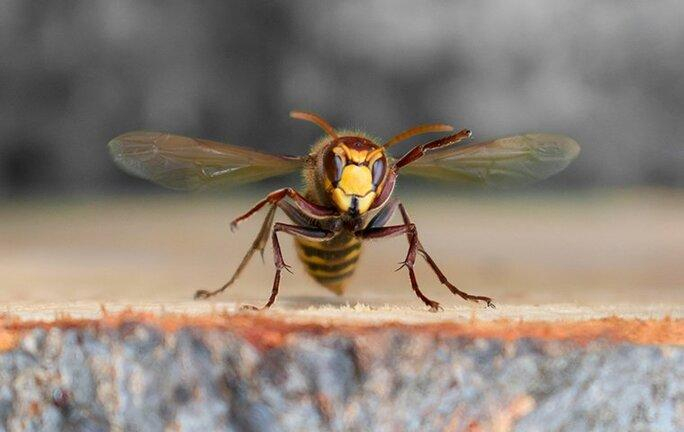
JD Whitty -
Phorid flies are small, but what sets them apart is how they look. Red eyes, wings, and legs are on a black body with black legs. Another distinctive feature of their antennae is that they have two pointed "horns" on top that resemble the rear of an ant head.
Despite not being considered a true predator, phorid flies merit a place on this list since they frequently consume fire ants. These are parasites that breed within the fire ant bodies. They then decapitate the ant by eating their way out of it with their larvae. That phorid flies are frequently utilized as natural pest management against fire ants should not be a surprise. There are phorids all throughout the planet, with the exception of Antarctica because of its extreme cold. However, people cannot access them. These flies may only be bought by government organizations for release. Due to the environmental degradation brought on by people encroaching on its region, this species of fly now mostly feeds on invading species instead of the native Australian ants that it once preyed upon.
These particular flies deposit their eggs within or close to the ants they are eating, so the larvae will have food available for them as soon as they emerge. These larvae consume both the interior and outside of the ant. These larvae create cocoons once they have completed eating in order to eventually develop into adult flies.
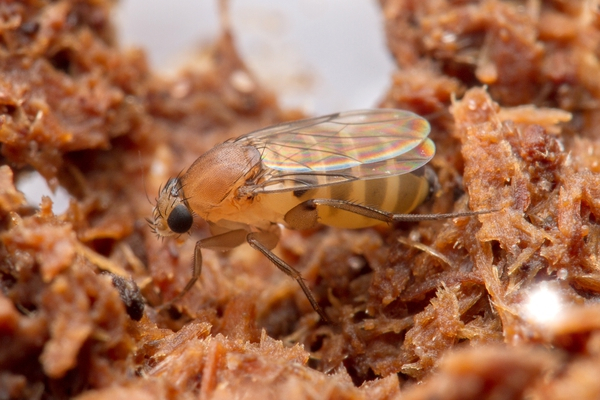
ncsu.edu Márcio Dias -
Lycaenidae butterflies, often known as blues, hairstreaks, and coppers, are known to have a range of intriguing interactions with ants. The majority of the host plants' leaves, flowers, and seeds are consumed by lycaenid butterfly caterpillars. Additionally, they contain unique glands that produce delicious juice. Just like they do with the honeydew of aphids or scale insects, the ants are drawn to the glands and feed on the secretions. By disguising its larvae with the ant's scent, this stunning butterfly lures ants to it. By doing this, the blue butterfly tricks ants into thinking the offspring is their own. As a result, the ants take it to their nests to take care of it. The larvae imitate the queen ant's scent and voice, and the colony treats them like royalty as a result.
The ants effectively feed the larvae, which allows them to develop swiftly. For up to 11 months, these blue butterflies spend their time in ant nests. They continue to consume ants throughout this phase. Finally, they kill and consume a great number of ants.
Some caterpillars have additional glands that secrete compounds to further confuse and placate the ants. The glands on the caterpillar of the delicate Danish Alcon blue butterfly (Maculinea Alcon) trick foraging worker ants into carrying the caterpillar back to the nest. The guard ants relax nearby as the caterpillar kills and consumes ant larvae after it has entered. In reality, the ants feed and care for the pink caterpillar thinking it is one of their own larvae. The caterpillar eventually changes into a pupa, but it stays underground where the ants can keep it safe. The butterfly must swiftly leave the anthill before it is detected since ants will not attack it until it emerges as an adult butterfly.
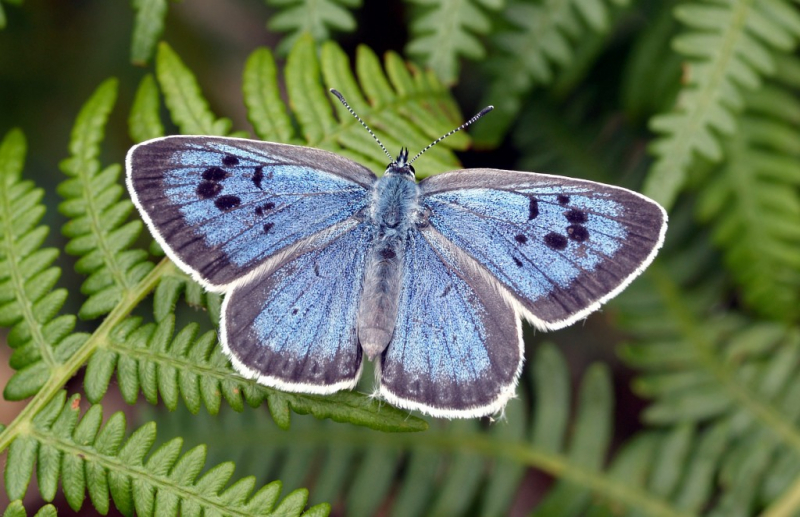
pbs.org BBC Earth -
Ground-dwelling beetles with a global distribution include the Bombardier Beetles of the Order Coleoptera and Family Carabidae (excluding Antarctica). Only one species (Pheropsophus Verticalis of the family Branchinini), out of the around 500 recognized species, may be found in Australia. The four tribes of the family Carabidae include Brachinini, Pausini, Ozaenini, and Metriini have different morphological characteristics.
Carnivorous bombardier beetles spend most of their time active at night. Bombardier beetles live beneath and between rocks in an environment with ants that are often found around lakes or streams. Bombardier Beetles have accordingly evolved defense measures to ward off ants and other predators. The Bombardier Beetle may shock or kill prospective predators by rapidly ejecting a heated chemical fluid with a loud "popping" sound.
This predatory beetle eats a large proportion of ants. In contrast to other insects that lure ants into feeding on them, Bombardier beetles storm ant colonies and devour them. Any ant that gets in their way, these predators kick it with their legs. These beetles absorb some formic acid from the ants they consume, which they then employ to protect themselves from other predators. When threatened, the Bombardier beetle squirts acid into the assailant's eyes.
Bombardier beetles frequently deposit their eggs very next to a prospective food supply, such as a decomposing animal carcass. The larva, which develops into an egg after hatching, can use the food supply for several weeks.
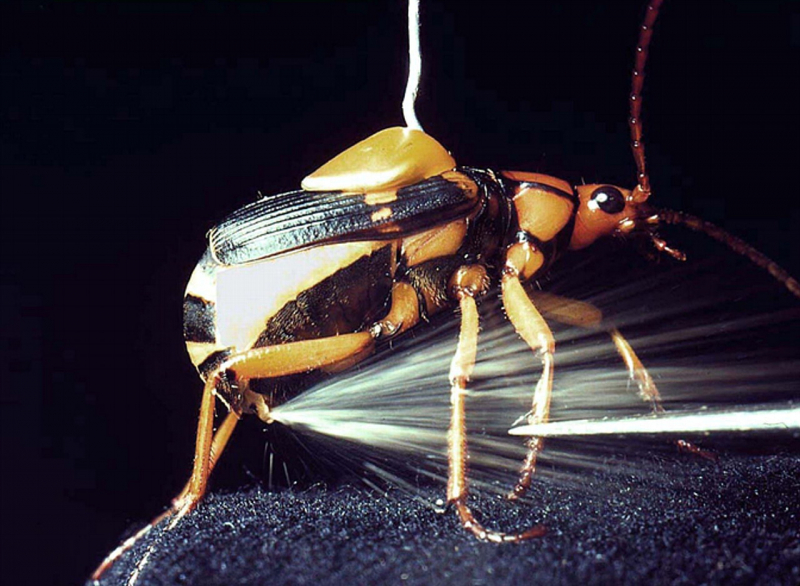
lizwason.wordpress.com BBC Earth -
The primary foods that a praying mantis consumes include arthropods, bugs, honey bees, flies, and tiny birds. They do, however, occasionally consume ants. Ants are often adept at protecting themselves from attackers, but they are powerless against a mantis.
Adult praying mantises have been observed eating ants alive and can grow up to four or five inches in length. Even though they are often good at protecting themselves from predators, ants cannot resist a mantis attack. The ant has little hope of escaping once the mantis gets it in its grip. A typical ant is around one-fifth the size of a typical praying mantis. The hues of praying mantises vary; some are brown, green, or even vivid. The verdant foliage of their native habitat in Central America makes it simple for them to blend in. The ants that walk next to them frequently do not see them. The mantis does not even need to entice the ants closer to them because they are only a few millimeters away.
When baby praying mantis hatch from their eggs, they immediately begin to feed. When they are young, they often consume insects smaller than ants, but as they get older, their diet will become more diverse and they will start to eat more than one kind of food. In Central America, during the summer, there are often enough little insects to eat by baby mantis. These months see the emergence of their eggs, maybe as a result of the abundance that helps them survive. They often consume microscopic insects like aphids. As they mature, they will begin to consume larger insects including ants, beetles, and grasshoppers.
BEANZ31424 Scarlett Zhang -
Many ant-eating birds, including woodpeckers, nuthatches, and chickadees, are frequently seen in gardens and yards because they prey on ants and other pests. These birds typically eat ants that are crawling across trees and in gardens. Most birds regularly consume ants, some ants are essential to their diets while others are more opportunistic.
For smaller birds, eating ants makes a lot more sense, but larger birds only sometimes do so since it takes a lot of energy to catch them, and bigger, less agile birds need a lot more ants to fulfill their nutritional demands.
Northern Flickers, Pileated Woodpeckers, European Green Woodpeckers, and Downy Woodpeckers are regularly spotted in backyards and gardens looking for ants, larvae, and eggs. In general, compared to other bird species, woodpeckers eat more ants. Sometimes, ants make up more than half of a woodpecker's diet. They will search the ground for food, burrow into the earth with their beaks, then devour the ants with their sticky tongues. The northern flicker and ground-feeding green woodpecker are more prone to employ this strategy. On cedar trees, other woodpeckers, like the Pileated Woodpecker, may hunt for ants. They use their powerful beaks to make wide, rectangular incisions in an effort to make certain black carpenter ants rich. Then hundreds of ants will be sucked up and thoroughly swallowed.
Jon7555 Jarekthroughthelens -
Lizards are one of the biggest predators of ants that eat ants. Ants are a favorite food of lizards. Almost every ant that is around may be seen and smelled by lizards thanks to their keen senses. The fence lizards, skinks, and geckos that inhabit our gardens and occasionally enter our houses are mostly insectivores. Because they consume insect pests like roaches and ants, these lizards are advantageous to mankind.
In the American West, harvester ants with a poisonous sting and strong mandibles for biting are the main source of food for horned lizards. It has long been a mystery how the lizards consume this perilous treat without having their internal organs pulled out. Scientists have now discovered the answer that the lizards smother the ants in mucus before consuming them whole.
Research on the diet of Eastern Fence Lizards was published in the Canadian Journal of Zoology in 2018. (Sceloporus undulatus). It was discovered that ants make up 50% of the meals of adult lizards and 80% of the diets of juvenile lizards. The fact that fence lizards consume both native and invasive ant species, including fire ants, was another significant discovery discovered by this study. Although fire ants carry a high level of venom, fence lizards appear to have developed a resistance to it.
Since they are too little to be a significant source of nutrition on their own, ants are often not a top choice of food for most lizards. They have a tough, indigestible exoskeleton that is made of chitin. Lizards would be far better off pursuing larger, more energy-dense insects.
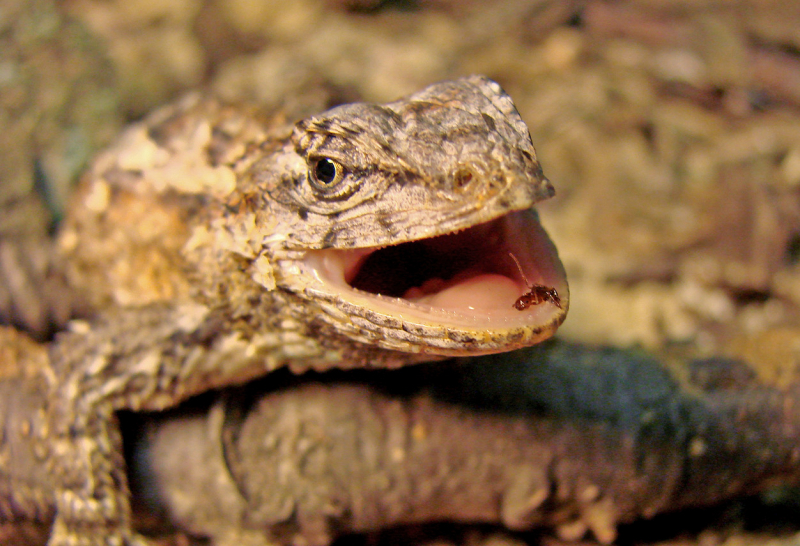
thelizardlog.wordpress.com MyBackyardBirding -
The majority of people are immediately surprised that a caterpillar is one of the 10 Predators of Ants that Eat Ants because it is a herbivorous animal when they see one. Although some caterpillars like munching on leaves, other types of caterpillars feed on newly hatched eggs and young ants. The majority of ants won't be able to bite into the delicate flesh of some caterpillars because of their strong carapaces. It is simple for most caterpillars to deceive ants since they often rely on their sense of smell to determine whether something is an ant or another bug. Caterpillars like the Alcol Blue Caterpillar will impersonate an ant to gain freedom and access to the colony's young ants.
Some species' attendant ants have been shown to exhibit slowed locomotor activity as a result of the secretions from dew patches and nectar glands, which have been demonstrated to change the levels of neurotransmitters, notably dopamine, in their brains. As a result, the ants become even more devoted to the caterpillars and more aggressive toward their parasites and predators. In these situations, it is preferable to think of these ostensibly mutualistic relationships as reciprocal parasitisms, where natural selection may transform each partner's outsmarting tactics into a complex coevolutionary arms race.
When the number of tending ants is too high or the caterpillar wants to move, it rhythmically everts a pair of tentacle organs or touches organs to fend off the ants. Caterpillars are guided toward ant aggregations by ciliary tufts at the ends of these organs, which also contain ant pheromone receptors.
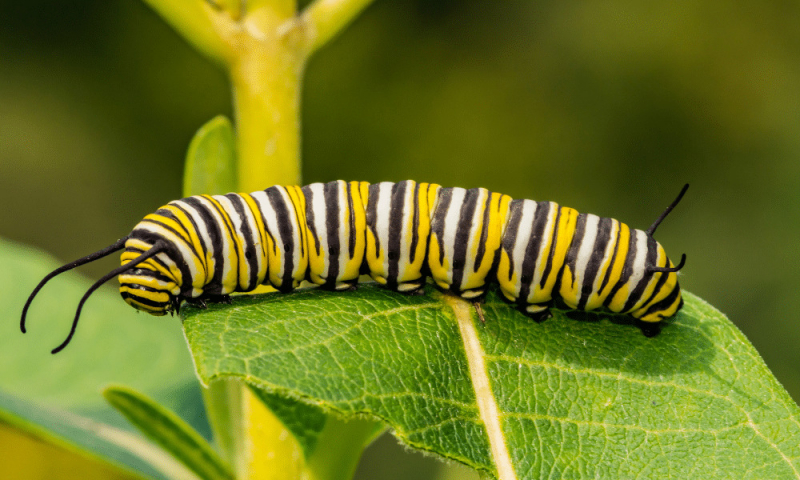
pestsbanned.com 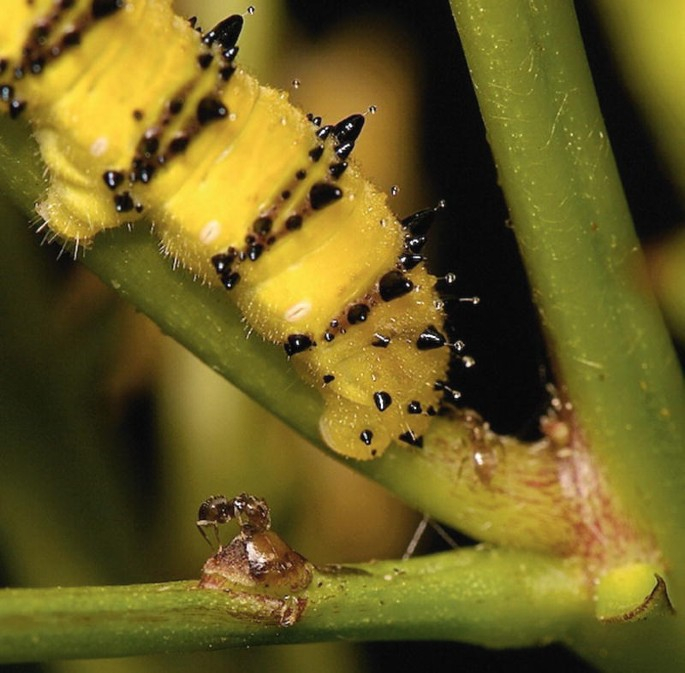
springer.com












